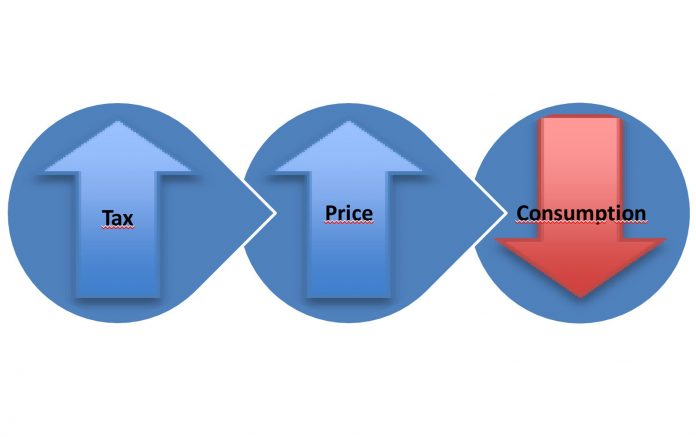By Jeffrey Drope, PhD; Cary Adams, MBA; Clifford E. Douglas, JD; Jacqui Drope, MPH; and Sonali Johnson, PhD
Posted: December 2018

There is clear evidence of success in recent global efforts to curb tobacco use, the largest preventable cause of disease and premature death in the world. Since 2012, global cigarette consumption has declined slightly each year from a high of approximately 6.3 trillion sticks; the proportion of people using tobacco has also decreased (less than 21% of adults report current smoking). However, this success is uneven and is largely dependent on governments’ commitment to and level of effectiveness in implementing tobacco-control policies. The many existing examples of successful government action to ameliorate the tobacco epidemic demonstrate that tobacco-control policies work; however, there is justified concern that too many governments have been slow to strengthen their countries’ tobacco-control policies.

In recent years, the tobacco-control community has developed and refined a set of evidence-based provisions that have contributed significantly to reducing tobacco use. These measures are enshrined in the World Health Organization’s (WHO) Framework Convention on Tobacco Control, which came into force in 2005 and to which most countries are now a party. Most of these measures aim to reduce the demand for tobacco including increasing tobacco taxes, expanding smoke-free environments, requiring stronger warnings on tobacco packaging and in advertisements (where permitted), and restricting the marketing of tobacco products.
Among the proven policy interventions, the most effective tobacco-control measure is substantially increasing excise taxes on tobacco products. The relationship is straightforward: governments raise taxes, tobacco companies typically raise prices to preserve their profits, and the higher prices deter consumption. Notably, consumption decreases more among young people and those with lower income, thereby protecting several potentially more vulnerable groups. Because the decline in consumption is typically less than the tax increase, countries not only benefit from lower consumption—including lower healthcare costs and higher productivity—but also from increased tax revenues. Some governments are reinvesting a portion of these revenues into healthcare, further benefitting societal well-being. In the Philippines, a large excise tax increase on tobacco products in 2013 contributed greatly to the decline of more than one million smokers, and the tax revenue is helping to provide universal healthcare for millions of low-income Filipinos. Unfortunately, the WHO reported in 2017 that only 760 million people live in countries where tax levels reach the recommended 75% of tobacco price.
In the Philippines, a large excise tax increase on tobacco products in 2013 contributed greatly to the decline of more than one million smokers, and the tax revenue is helping to provide universal healthcare for millions of low-income Filipinos.

Creation of smoke-free environments makes the places where people live, work, eat, and engage in recreational activities markedly healthier for everyone, particularly for nonsmokers. As of early 2018, less than 20% of the world’s population enjoyed some protection from second-hand smoke through smoke-free public and work places. The implementing countries have enjoyed immediate health rewards after going smoke free. For example, research demonstrates a significant decrease in community rates of heart attack in jurisdictions that have gone smoke free. Furthermore, smoke-free places serve to “de-normalize” smoking, making smoking a less acceptable behavior. Moreover, youth observe smoking less frequently and are less likely to initiate smoking as a result.
By 2017, a little more than half of the world’s population lived in countries where tobacco packaging has large, graphic warning labels to alert people to the dangers of tobacco use. Taking the next step, an increasing number of countries have emulated Australia by legislating that tobacco products can only be in plain, standardized packs, eliminating logos and colors, and thereby diminishing the appeal to consumers, including children.

The main reason that tobacco products remain popular globally is because the tobacco industry markets its products aggressively. In the United States, the tobacco industry’s annual marketing budget is consistently more than $8 billion. Tobacco firms seek to present products that convey glamour, coolness, and success. The health community and government authorities must vigorously present the starkly contrasting narrative of disease and death: smoking steals an average of nearly 11 years from a smoker’s life, and more than half of smokers die from a tobacco-attributable disease.

The vector for tobacco use is distinctly human: the tobacco industry fights tobacco control by almost any means including litigation, aggressive lobbying, and even corruption. The best way to fight this scourge is to work together to champion proven tobacco-control measures. Countries where broad coalitions of participants from different parts of the health, consumer, environmental, academic, and human rights sectors are speaking out loudly have realized greatest success in driving down tobacco use and saving lives. At the WHO Framework Convention on Tobacco Control Eighth Conference of the Parties in October, 2018, Parties worked together again toward more effective implementation. ✦
About the Authors: Dr. Drope is vice president of economic and health policy research for the American Cancer Society and professor in residence of Global Public Health at Marquette University. Mr. Adams is chief executive offi cer of the Union for International Cancer Control. Mr. Douglas is vice president for tobacco control for the American Cancer Society and adjunct professor at the University of Michigan School of Public Health. Ms. Drope is managing director of Global Cancer Prevention and Early Detection at the American Cancer Society. Dr. Johnson is head of advocacy at the Union for International Cancer Control.
References:
1. Global Adult Tobacco Survey – Philippines Country Report 2015. World Health Organization website. who.int/tobacco/surveillance/survey/gats/phl_country_report.pdf?ua=1. Accessed September 11, 2018.
2. Drope J, Schluger N, Cahn Z, et al. The Tobacco Atlas. The Tobacco Atlas website. tobaccoatlas.org/wp-content/uploads/2018/03/TobaccoAtlas_6thEdition_LoRes_Rev0318.pdf. Accessed September 11, 2018.
3. Lightwood J, Glantz S. 2009. Declines in Acute Myocardial Infarction following Smokefree Laws and Individual Risk Attributable to Secondhand Smoke. Circulation 124, 14: 1373-1379.
4. World Health Organization. 2017. Global Report on the Tobacco Epidemic. Geneva: WHO
5. Federal Trade Commission. Federal Trade Commission Cigarette Report for 2015. Washington DC, 2017.











